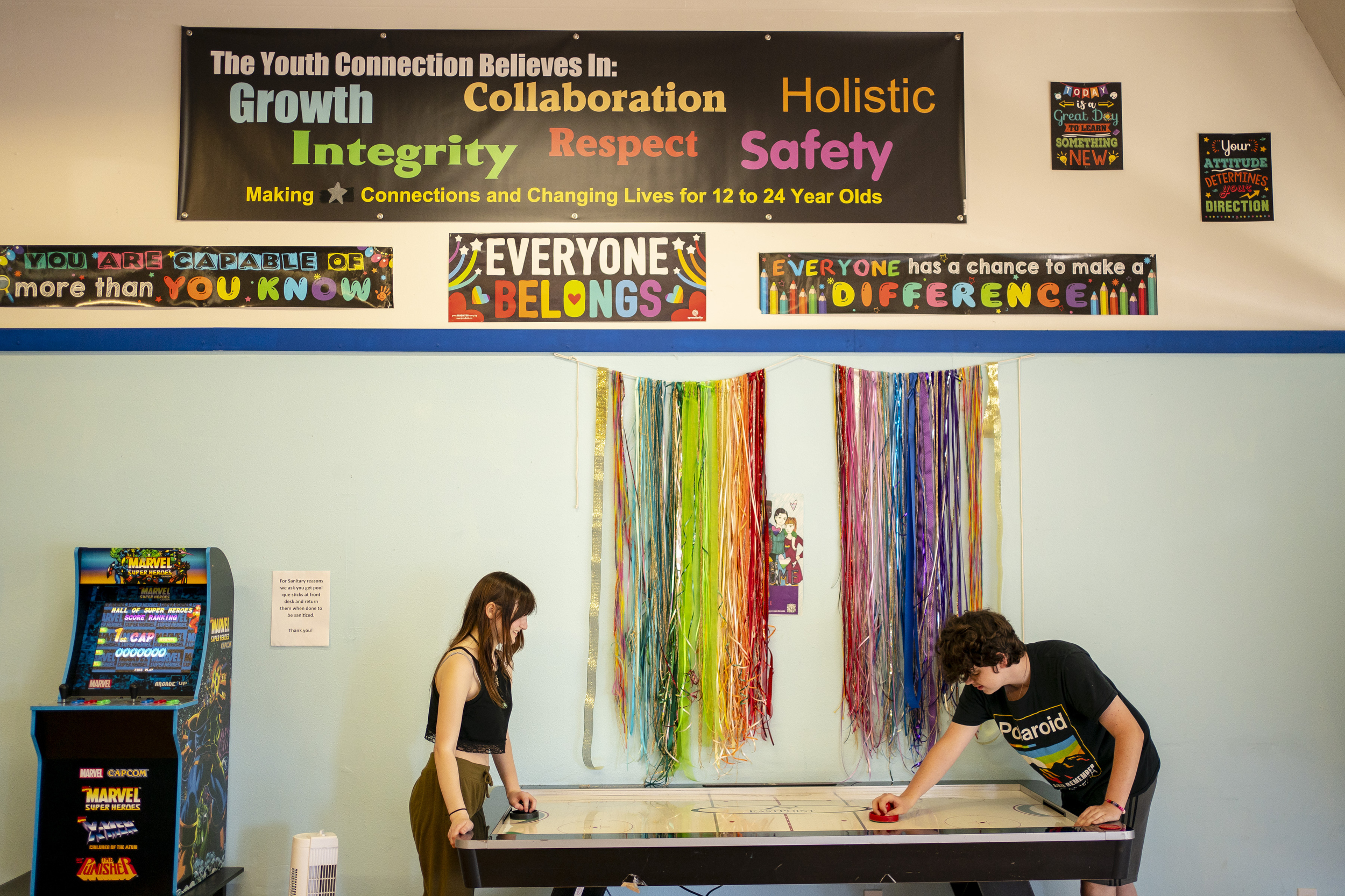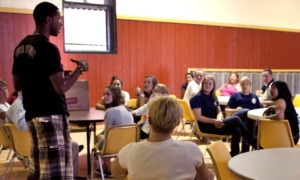The Youth Connection in Mason County, Washington, was already humming with quiet activity shortly after opening. A girl waited to see her case manager. One teen crouched at the refrigerator and browsed. The morning sun streamed through tall front windows.
The center, which serves anyone ages 12 to 24, is kitted out: There’s an air hockey table, a pinball machine, three guitars (acoustic and electric), an Xbox. A walled-off corner is dedicated to the clothing closet — racks of shirts and pants and shelves of personal hygiene items, free to all.
“I really wanted this space to be as uninhibited and welcoming as possible so that anybody can come and get what they need without having to feel their pride is hurt,” Susan Kirchoff, the center’s director and one of its co-founders, said of the closet during an interview one morning in late June.
Many kids who come to the center want a hangout spot, Kirchoff said. Others, though, desperately need help because they are close to becoming, or already are, homeless.
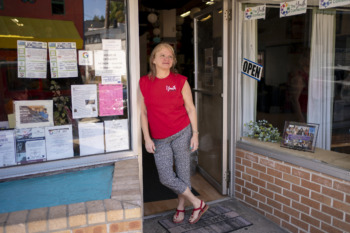
David Ryder for Crosscut
Susan Kirchoff, director and co-founder of The Youth Connection, a community center that provides a safe space for young people age 12 to 24.
Her voice grew soft and serious. “Young people did not wake up one day and say, ‘Please let me be homeless,’” Kirchoff said. Nevertheless, young people are homeless in Washington. Eventually, if they “get beat down and … can’t get past it,” Kirchoff said, their homelessness becomes almost chronic.
Washington’s policies to prevent youth and young adult homelessness are considered among the best in the country. In a 2021 report, the National Homelessness Law Center’s analyzed states’ “readiness to tackle the specific challenges of youth homelessness” and ranked Washington first among states, and second overall, behind Washington, D.C.
But the report noted that its rankings did not reflect states’ success in preventing youth homelessness, and Washington’s own data show its room for improvement, especially for youth who have been through public systems.
A report published in June by the Department of Social and Health Services showed that nearly 1,100, or 15%, of the more than 7,000 young people who left state systems — foster care, the juvenile justice system, or inpatient behavioral health treatment — between July 2020 and June 2021 were homeless one year later.
In one way, those figures represent improvement. In 2017, 20% of young people exiting state systems were homeless a year later.
But major inequities persist. The report showed that compared to 2017, the percentages of young people who identified as Black; Hispanic or Latino; and American Indian or Native Alaskan and who were homeless a year after leaving state systems had actually increased. Youth who identify as LGBTQ+ are also overrepresented among homeless youth.
A year ago, Washington state dedicated $5.4 million to four initiatives, created with the passage of House Bill 1905, to prevent young people discharged from state systems from ending up on the streets. The legislation did not explicitly address racial inequities.
Advocates say that money has flowed to young people by paying their rent, security deposits, or utility bills, or by fueling creative solutions for them to find housing. Spending data suggest that this happened inconsistently across grantees and programs. A delay in one program left youth without promised services for months. When the fiscal year ended in June, other programs ran out of time to put their funding toward helping young people, and many of these use-it-or-lose-it dollars returned to state coffers.
“It is typical to see a ramp-up period when organizations initiate new programs,” said Kim Justice, executive director of the state’s Office of Homeless Youth, which is part of the state Department of Commerce. “It takes some time to hire staff and develop their program and infrastructure before they are able to provide services and spend funds.”
One key initiative — a Rapid Response Team to triage and connect young people to services including civil legal aid, housing support and family reconciliation services after being discharged from a state-run system — remains behind schedule. Launches planned first for April, then July, never happened. The team recently began taking referrals on Aug. 7.
Other problems have emerged, too.
Here’s what’s working in Washington’s latest efforts to help bridge the gap from state youth systems to stable housing — and what’s not.
1) Youth Diversion Infrastructure Project
This newly established program works to identify young people who have left state systems who remain at risk of homelessness, in order to help them find or keep housing that works for them — say, with a relative — by covering related costs. The Office of Homeless Youth contracted with two organizations, A Way Home Washington and Building Changes, to lead it.
The program began helping people and distributing funds in March. By the end of June, administrators reported getting more than $177,000 out to at least 73 households for rental assistance, housing deposits, application fees and other expenses. Still, by early July, Building Changes had spent less than a third of the $1.3 million it was granted for the fiscal year.
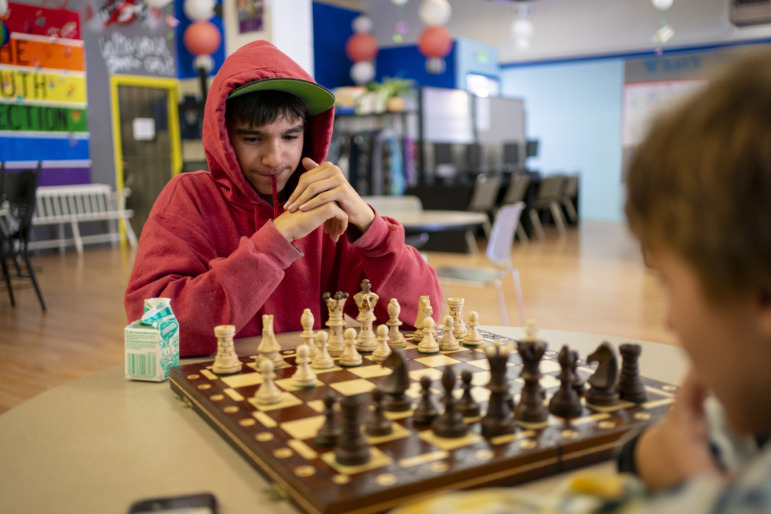
David Ryder for Crosscut
Riley, 13, left, plays chess with Bryan, 15 at The Youth Connection.
A spokesperson for Building Changes said that “there was a very short runway to spend the $1.3 million, but we are excited to see that spending is ticking up in communities.”
In July, Crosscut also reported A Way Home Washington had allowed the private data, including full names, birthdates and sensitive personal histories, of hundreds of young people to be accessible through its online data dashboards.
Investigations into the cause and impact of the data exposure remain ongoing at both the Department of Commerce and A Way Home Washington.
2) System of Care grants
A similar but separate initiative to provide cash assistance for overcoming common barriers has also spent less than half of its funding in its first year.
These System of Care grants help selected nonprofits pay for wide-ranging necessities for young people who’ve spent time in a state system: clothing for a job interview, school supplies, even rent.
In 2022, the Office of Homeless Youth awarded around $1.3 million in these grants to eight nonprofits across Washington, including Mason County’s Youth Connection, to serve young people exiting any state system of care, and another $500,000 to two nonprofits to serve young people being discharged from inpatient behavioral health centers.
[Related: Washington state young adults often end up homeless after leaving treatment]
Kirchoff estimated that of the center’s clients — nearly 500 since its founding in 2018 — 70% have been through foster care, the juvenile justice system or inpatient behavioral health treatment.
The Youth Connection has used its System of Care funding to lease two apartments that it rents — with the center often paying some or all of the rent — to young adults. In another case, it covered rent for a mother whose child was in and out of the courtroom so much that she was missing work and losing vital income.
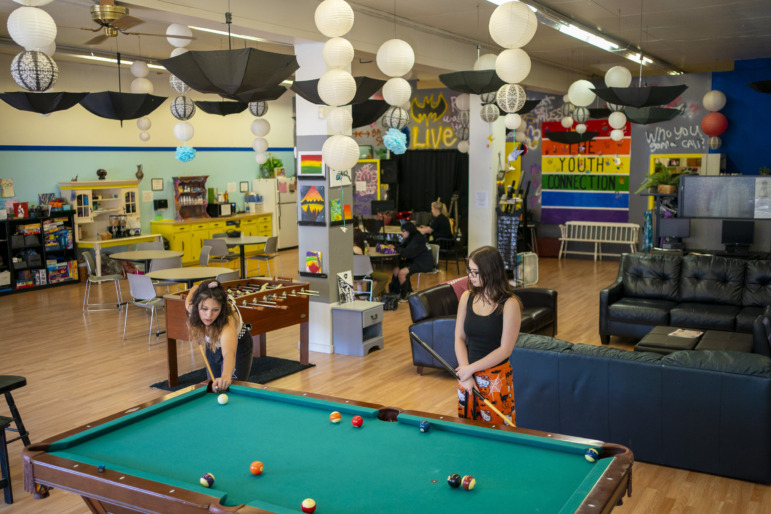
David Ryder for Crosscut
MJ, 14, left, and Faith, 14, right, play pool at The Youth Connection in Shelton. Seventy percent of Youth Connections young clients have been through foster care, the juvenile justice system, or behavioral health treatment.
It took the Youth Connection some time to put grant dollars to use. It had to secure apartments and hire staff to manage the grant.
By the end of June, Kirchoff estimated, the Youth Connection had spent about $204,000 of its $240,000 grant for fiscal year 2023. She had just learned that funding was renewed for another two years.
“I can’t spend it all this year, but I will next year,” Kirchoff said, referring to the renewed funding.
The only other nonprofit that spent a substantial portion of its grant was Ryan’s House, on Whidbey Island, which by March had used one-third. Spending information on the eighth grantee, Volunteers of America in Spokane, appeared to be missing from data released in response to a public records request.
According to the Department of Commerce, 44% of the roughly $1.8 million in System of Care grants had been spent by June 7, with just a few weeks remaining in the fiscal year.
3) Rapid Response Team
A nearly $1 million multi-agency program to help young people on the verge of exiting state systems of care into homelessness has also gotten off to a slow start. The program launched on Aug. 7, despite its initial goal of starting months ago.
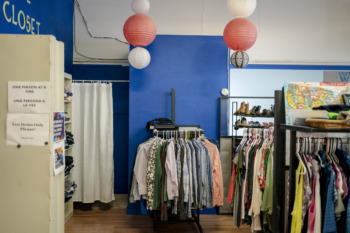
David Ryder for Crosscut
Free clothing is available for clients at The Youth Connection in Shelton.
The Rapid Response Team, as it was initially dubbed, also recently adopted a new moniker, dropping the “rapid” and becoming the Youth and Young Adult Housing Response Team.
Since its work officially began in January, launch dates have come and gone. The four agencies involved in the team — the Department of Children, Youth, and Families; the Office of Homeless Youth (OHY); the Department of Social and Health Services; and the Health Care Administration — initially aimed to finish designing and implementing a referral system, which would allow them to help young people find housing, by April.
By the end of July, a sparse website and an email address had been created. Three new staff had started their jobs at the beginning of that month. The team had informally handled six cases. Since launching Aug. 7, the team has received one referral.
“It’s frustrating, how long it’s taking the Rapid Response Team to get going,” Rep. Tana Senn, who introduced House Bill 1905, said in late June, although she acknowledged that the government, like everyone else, has struggled with hiring post-COVID.
For each of the next two fiscal years, the team has been allocated $984,000.
Asked to explain the delays, Matt Davis, systems change manager at OHY who is involved in the team, cited staffing, bureaucracy and a referral process that was “kind of a bear to design.”
The team required several new positions across different agencies, he said. But going through human resources to gain approval for job postings took “a lot longer than we would have hoped,” he added. So did finding a qualified candidate for the OHY position.
Another challenge, Davis said, has involved navigating different agencies’ confidentiality responsibilities to those who are referred to the team.
The team also seems uncertain about its core purpose. Legislation defined it, perhaps too broadly, as a team “that is prepared to respond appropriately to support youth and young adults exiting a publicly funded system of care.”
Taku Mineshita, director of integrated systems of care at the Department of Children, Youth, and Families, wrote in an email, “We are continuing to grapple with scrutinizing the intent” of House Bill 1905.
4) H-SYNC
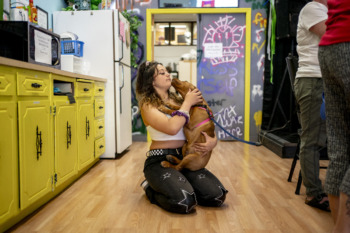
David Ryder for Crosscut
MJ, 14, plays with director Susan Kirchoff’s puppy, Copper, at The Youth Connection.
Four years ago, King, Snohomish, Kitsap, and Okanogan Counties began using a University of Washington-developed model to assess the youth involved in the court system and identify those at risk of becoming homeless. House Bill 1905 allocated $625,000 to the YMCA of Greater Seattle to expand the model to Pierce and Spokane counties.
The program relies on data routinely collected by courts, assessing a young person’s history to gauge their risk of becoming homeless. Dr. Sarah Walker, who led the team that developed H-SYNC, has found that more than half of youth homelessness “is directly preceded by a family conflict resulting in the youth running away or being told to leave the home.”
A juvenile probation counselor refers high-risk youth to a navigator, who can connect the young person or their family to a variety of resources, explained Sheala Anderson, the director of H-SYNC at the Y Social Impact Center.
By May, with two months left in the fiscal year, about 45% of the money allocated had been spent, according to Shaun Frazier, the Y’s senior director of Community Housing and Homeless Services.
[Related: Researchers team up with court staff to help Washington homeless youth]
“While this is underspent, it makes sense since it took a while to get the original four counties fully up and running,” he said. In those four counties, the model had initially been privately funded, and in some, the transition to public funding was not seamless.
Overall, from July 2022 through May 2023, Anderson said, the money that was spent helped 145 young people.
***
Elizabeth Whitman is a freelance journalist in the Seattle area. She can be reached at elizabeth.whitman@proton.me.
This article is part of an ongoing series on homelessness in Washington state, done in collaboration with Crosscut. It is made possible in part by support from the Raikes Foundation. Youth Today and Crosscut maintain editorial control. You can read more stories from this series here.


